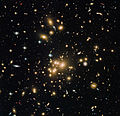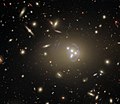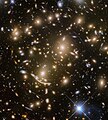Abell-Katalog
Der Abell-Katalog (engl.: Abell catalog of rich clusters of galaxies) ist ein Katalog von 4073 Galaxienhaufen.
Die erste Version des Katalogs wurde 1958 von George Ogden Abell veröffentlicht, entstand durch Inspektion der rotempfindlichen Aufnahmen des Palomar Observatory Sky Survey mit Hilfe einer Lupe und enthielt 2712 Galaxienhaufen.[1] 1989 wurde er um 1361 Haufen aus den zuvor nicht erfassten Teilen des Südhimmels ergänzt, die mit Hilfe von Aufnahmen des UK Schmidt-Teleskops gefunden wurden.[2] Neben den Koordinaten wurden Kennzahlen für die Mitgliederzahl, Kompaktheit und ungefähre Entfernung des Haufens angegeben.
Aufnahmekriterien
Jeder dieser Haufen umfasst mindestens 50 Galaxien zwischen der Helligkeit des dritthellsten Haufenmitglieds und zwei Magnituden schwächer (). Außerdem müssen die mindestens 50 Mitglieder, bei einer angenommenen Hubble-Konstante von , in einem Radius von 2 Megaparsec liegen, dem Abell-Radius.[1] Die Rotverschiebungen der Haufen gehen nominell bis , tatsächlich wurden für etliche Abell-Haufen später auch größere Werte gemessen.
Beispiele
- Abell 262 im Sternbild Andromeda.
- Abell 520 im Sternbild Orion.
- Abell 901 im Sternbild Löwe bildet zusammen mit Abell 902 einen Superhaufen.
- Abell S0373 Fornax-Galaxienhaufen: der zweitnächste Galaxienhaufen.
- Abell 1656 Coma-Galaxienhaufen: einer der bekanntesten Galaxienhaufen.
- Abell 1689 im Sternbild Jungfrau, eines der massenreichsten bekannten Objekte im Universum.
- Abell 1835 im Sternbild Jungfrau.
- Abell 2667 im Sternbild Bildhauer, durch den eine Kometengalaxie rast.
- Abell 3266 am Südsternhimmel, eine der größten Massenkonzentrationen im nahen Universum.
- Abell 3627 Norma-Galaxienhaufen: mit nur 210 Millionen Lichtjahren Entfernung ein recht naher und bekannter Galaxienhaufen.
- (c) ESA/Hubble, CC BY 4.0
HST-Aufnahme von Abell 1689
- (c) ESA/Hubble, CC BY 4.0
Abell 3827
- (c) ESA/Hubble, CC BY 4.0
Abell 370
Ein der Bezeichnung vorangestelltes S verweist auf Objekte des Südhimmels (1989er Katalog).
Weblinks
- Abell, Corwin and Olowin's Veröffentlichung und Katalog von 1989, bibcode:1989ApJS...70....1A
- Elektronische Form des Abell-Katalogs
- Abell's Veröffentlichung und Katalog von 1958, bibcode:1958ApJS....3..211A
Einzelnachweise
- ↑ a b G. O. Abell: The distribution of rich clusters of galaxies. A catalogue of 2712 rich clusters found on the National Geographic Society Palomar Observatory Sky Survey. In: The Astrophysical Journal Supplement Series. Band 3, 1958, S. 211 - 288.
- ↑ G. O. Abell, H. G. Corwin, R. P. Olowin: A Catalog of Rich Clusters of Galaxies. In: The Astrophysical Journal Supplement Series. Band 70, 1989, S. 1–138.
Auf dieser Seite verwendete Medien
(c) ESA/Hubble, CC BY 4.0
This detailed image features Abell 3827, a galaxy cluster that offers a wealth of exciting possibilities for study. It was observed by Hubble in order to study dark matter, which is one of the greatest puzzles cosmologists face today. The science team used Hubble’s Advanced Camera for Surveys (ACS) and Wide Field Camera 3 (WFC3) to complete their observations. The two cameras have different specifications and can observe different parts of the electromagnetic spectrum, so using them both allowed the astronomers to collect more complete information. Abell 3827 has also been observed previously by Hubble, because of the interesting gravitational lens at its core. Looking at this cluster of hundreds of galaxies, it is amazing to recall that until less than 100 years ago, many astronomers believed that the Milky Way was the only galaxy in the Universe. The possibility of other galaxies had been debated previously, but the matter was not truly settled until Edwin Hubble confirmed that the Great Andromeda Nebula was in fact far too distant to be part of the Milky Way. The Great Andromeda Nebula became the Andromeda Galaxy, and astronomers recognised that our Universe was much, much bigger than humanity had imagined. We can only imagine how Edwin Hubble — after whom the Hubble Space Telescope was named — would have felt if he’d seen this spectacular image of Abell 3827.
Autor/Urheber: NASA Hubble, Lizenz: CC BY 2.0
The Hubble Space Telescope imaged this giant, cosmic magnifying glass, a massive cluster of galaxies called Abell 2218. This "hefty" cluster resides in the constellation Draco, some 2 billion light-years from Earth.
The cluster is so massive that its enormous gravitational field deflects light rays passing through it, much as an optical lens bends light to form an image. This phenomenon, called gravitational lensing, magnifies, brightens, and distorts images from faraway objects. The cluster's magnifying powers provides a powerful "zoom lens" for viewing distant galaxies that could not normally be observed with the largest telescopes.
This useful phenomenon has produced the arc-shaped patterns found throughout the Hubble picture. These arcs are the distorted images of very distant galaxies, which lie 5 to 10 times farther than the lensing cluster. This distant population existed when the universe was just a quarter of its present age. Through gravitational lensing these remote objects are magnified, enabling scientists to study them in more detail.
The picture is dominated by spiral and elliptical galaxies. Resembling a string of tree lights, the biggest and brightest galaxies are members of the foreground cluster.
The colors in this picture yield clues to the ages, distances, and temperatures of stars, the stuff of galaxies. Blue pinpoints hot, young stars. The yellow-white color of several of the galaxies represents the combined light of many stars. Red identifies cool stars, old stars, and the glow of stars in distant galaxies. This view is only possible by combining Hubble's unique image quality with the rare lensing effect provided by the magnifying cluster.
For more information, visit: hubblesite.org/news_release/news/2000-07
Credit: NASA, Andrew Fruchter (STScI), and the ERO Team [Sylvia Baggett (STScI), Richard Hook (ST-ECF), Zoltan Levay (STScI)]Autor/Urheber: European Space Agency, Lizenz: CC BY 2.0
This extraordinary image from the NASA/ESA Hubble Space Telescope of the galaxy cluster Abell 2813 (also known as ACO 2813) has an almost delicate beauty, which also illustrates the remarkable physics at work within it. The image spectacularly demonstrates the concept of gravitational lensing.
In amongst the tiny dots, spirals and ovals that are the galaxies that belong to the cluster, there are several distinct crescent shapes. These curved arcs of light are strong examples of a phenomenon known as gravitational lensing. The image was compiled using observations taken with the Hubble Space Telescope’s Advanced Camera for Surveys (ACS) and Wide Field Camera 3 (WFC3).
Gravitational lensing occurs when an object’s mass causes light to bend. The curved crescents and s-shapes of light in this image are not curved galaxies, but are light from galaxies that actually lie beyond Abell 2813. The galaxy cluster has so much mass that it acts as a gravitational lens, causing light from more distant galaxies to bend around it. These distortions can appear as many different shapes, such as long lines or arcs.
This very visual evidence that mass causes light to bend has been famously used as a proof of one of the most famous scientific theories: Einstein’s theory of general relativity.
Credits: ESA/Hubble & NASA, D. Coe; <a href="https://creativecommons.org/licenses/by/4.0/" rel="noreferrer nofollow">CC BY 4.0</a>Autor/Urheber: Hubble ESA, Lizenz: CC BY 2.0
Abell 68, pictured here in infrared light, is a galaxy cluster. The effect of its gravity on light means it boosts Hubble's power, greatly increasing the telescopes ability to observe distant and faint objects. The fuzzy collection of blobs in the middle and upper left of the image is a swarm of galaxies, each with hundreds of billions of stars and vast amounts of dark matter. Distorted shapes visible throughout the field of view are distant galaxies whose light has been bent and amplified by the cluster.
More information: <a href="http://www.spacetelescope.org/images/heic1304a/" rel="nofollow">www.spacetelescope.org/images/heic1304a/</a>
Credit:
NASA & ESA. Acknowledgement: N. Rose(c) ESA/Hubble, CC BY 4.0
With the final observation of the distant galaxy cluster Abell 370 — some five billion light-years away — the Frontier Fields program came to an end. Abell 370 is one of the very first galaxy clusters in which astronomers observed the phenomenon of gravitational lensing, the warping of spacetime by the cluster’s gravitational field that distorts the light from galaxies lying far behind it. This manifests as arcs and streaks in the picture, which are the stretched images of background galaxies.
Celebrating its 50th anniversary in 2016, the TV series "Star Trek" has captured the public’s imagination with the signature phrase, "To boldly go where no one has gone before." NASA's Hubble Space Telescope doesn't "boldly go" deep into space, but it is "boldly peering" deeper into the universe than ever before to explore the warping of space and time and uncover some of the farthest objects ever seen.
When "Star Trek" was first broadcast in 1966, the largest telescopes on Earth could only see about halfway across the universe - the rest was uncharted territory. But Hubble's powerful vision has carried us into the true "final frontier."
This is epitomized in the latest Hubble image released today in time for the new motion picture "Star Trek Beyond." The Hubble image unveils a very cluttered-looking universe filled with galaxies near and far. Some are distorted like a funhouse mirror through a warping-of-space phenomenon first predicted by Einstein a century ago.
In the center of the image is the immense galaxy cluster Abell S1063, located 4 billion light-years away, and surrounded by magnified images of galaxies much farther.
Thanks to Hubble's exquisite sharpness, the photo unveils the effect of space warping due to gravity. The huge mass of the cluster distorts and magnifies the light from galaxies that lie far behind it due to an effect called gravitational lensing. This phenomenon allows Hubble to see galaxies that would otherwise be too small and faint to observe. This "warp field" makes it possible to get a peek at the very first generation of galaxies. Already, an infant galaxy has been found in the field, as it looked 1 billion years after the big bang.
This frontier image provides a sneak peak of the early universe, and gives us a taste of what the James Webb Space Telescope will be capable of seeing in greater detail when it launches in 2018.
The cluster contains approximately 100 million-million solar masses, and contains 51 confirmed galaxies and perhaps over 400 more.
The Frontier Fields program is an ambitious three-year effort, begun in 2013, that teams Hubble with NASA's other Great Observatories - the Spitzer Space Telescope and the Chandra X-ray Observatory - to probe the early universe by studying large galaxy lusters. Identifying the magnified images of background galaxies within these clusters will help astronomers to improve their models of the distribution of both ordinary and dark matter in the galaxy cluster. This is key to understanding the mysterious nature of dark matter that comprises most of the mass of the universe.
The Hubble Space Telescope is a project of international cooperation between NASA and the European Space Agency. NASA's Goddard Space Flight Center in Greenbelt, Maryland, manages the telescope. The Space Telescope Science Institute (STScI) in Baltimore, Maryland, conducts Hubble science operations. STScI is operated for NASA by the Association of Universities for Research in Astronomy in Washington, D.C.
To learn more about Hubble’s impact on our pop culture, and how you can get involved with #spothubble, visit:
<a href="http://www.nasa.gov/content/goddard/2016/spothubble" rel="nofollow">www.nasa.gov/content/goddard/2016/spothubble</a>
For images and more information about Abell S1063 and Hubble, go to: • <a href="http://hubblesite.org/news/2016/28" rel="nofollow">hubblesite.org/news/2016/28</a> • <a href="http://www.nasa.gov/hubble" rel="nofollow">www.nasa.gov/hubble</a> • <a href="http://www.spacetelescope.org/news/heic1615" rel="nofollow">www.spacetelescope.org/news/heic1615</a>
View the full press release <a href="https://www.nasa.gov/feature/goddard/2016/nasa-s-hubble-looks-to-the-final-frontier" rel="nofollow">here</a>.
<a href="http://www.nasa.gov/hubble" rel="nofollow">NASA Hubble Space Telescope</a>
Follow us on <a href="https://twitter.com/NASAHubble" rel="nofollow">Twitter</a>(c) ESA/Hubble, CC BY 4.0
This new Hubble image shows galaxy cluster Abell 1689. It combines both visible and infrared data from Hubble’s Advanced Camera for Surveys (ACS) with a combined exposure time of over 34 hours (image on left over 13 hours, image on right over 20 hours) to reveal this patch of sky in greater and striking detail than in previous observations.
This image is peppered with glowing golden clumps, bright stars, and distant, ethereal spiral galaxies. Material from some of these galaxies is being stripped away, giving the impression that the galaxy is dripping, or bleeding, into the surrounding space. Also visible are a number of electric blue streaks, circling and arcing around the fuzzy galaxies in the centre.
These streaks are the telltale signs of a cosmic phenomenon known as gravitational lensing. Abell 1689 is so massive that it bends and warps the space around it, affecting how light from objects behind the cluster travels through space. These streaks are the distorted forms of galaxies that lie behind the cluster.












